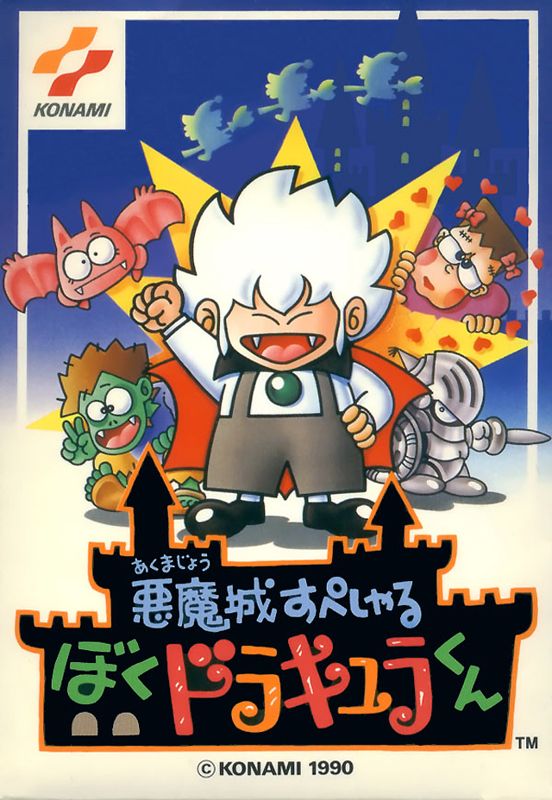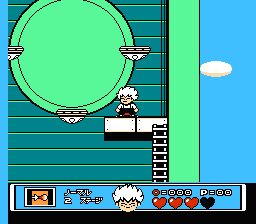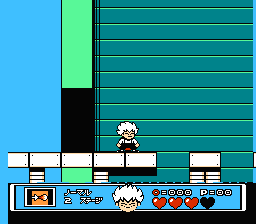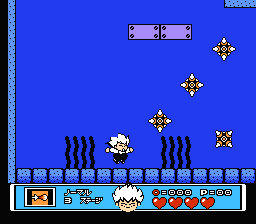Retro Replay Review
Gameplay
Akumajō Special: Boku Dracula-kun delivers straightforward side-scrolling action that will feel instantly familiar to fans of classic platformers. You guide the pint-sized protagonist through nine diverse stages, each packed with standard jump-and-shoot mechanics. The controls are tight, ensuring that every leap and projectile feels responsive—a must for navigating the occasional precision platforming sections and enemy barrages.
(HEY YOU!! We hope you enjoy! We try not to run ads. So basically, this is a very expensive hobby running this site. Please consider joining us for updates, forums, and more. Network w/ us to make some cash or friends while retro gaming, and you can win some free retro games for posting. Okay, carry on 👍)
Where the game really adds flavor is in its spell and special-attack system. As you defeat foes, you collect coins that can be exchanged for mini-games between levels, offering a fun diversion and a chance to bolster your coin stash. Meanwhile, progression rewards you with new magical abilities—transforming into a bat for aerial maneuvering, unleashing spread shots, or deploying homing attacks to clear the screen. These powers not only mix up the core action but also encourage strategic use against tougher mid-bosses and end-of-level challenges.
The pacing across the nine stages is well-balanced. Early levels emphasize basic platform jumps and introductory enemies, while later areas ramp up the difficulty with more complex layouts and enemy patterns. Although the game doesn’t break new ground in terms of genre innovation, its blend of reliable platforming, light RPG elements, and interstitial mini-games makes for an engaging loop that keeps you invested from start to finish.
Graphics
Visually, Boku Dracula-kun embraces a vibrant, cartoonish aesthetic that parodies the darker tone of its Castlevania forebears. Sprites are bold and expressive—Kid Dracula’s cheeky grin after collecting items and the exaggerated animations of snarling demons showcase Konami’s knack for character design even on limited hardware. The result is a colorful, memorable cast that stands out amid the pixel art landscape of its era.
Backgrounds in each stage are distinct and detailed, ranging from the gothic spires of Dracula’s Castle to bustling New York City streets, serene seascapes, and the sandy ruins of ancient Egypt. These varied settings not only provide visual variety but also capture the tongue-in-cheek tone of the game, as familiar landmarks are exaggerated for comedic effect. Layered parallax scrolling is minimal, yet the solid contrast between foreground and background elements ensures clarity during hectic action sequences.
Special effects for spells and attacks are surprisingly polished. Whether unleashing a shower of bat-shaped projectiles or watching a homing shot lock onto targets, the animations are smooth and easy to follow. Even the mini-games display unique graphical flourishes, reinforcing the game’s overall charm. While not a technical showcase, Boku Dracula-kun’s visuals punch well above their weight in charm and personality.
Story
At its heart, Boku Dracula-kun is a playful parody of the venerable Castlevania series. Instead of the stoic Belmont clan, you assume the role of a mischievous young Dracula, roused from slumber by the nefarious Garamos. This inversion of the usual vampire-hunter premise sets a lighthearted tone from the very beginning, casting the villainous mastermind as the protagonist’s unwelcome alarm clock.
The narrative unfolds across multiple exotic locales—each stage feels like a postcard from an adventure. After escaping the depths of Dracula’s own castle, Kid Dracula jets off to New York to confront Garamos’s urban mischief, then plunges into underwater caverns before finally exploring Egypt’s desert tombs. The story never aims for epic drama; instead, it maintains a breezy pace that complements the arcade-style gameplay and reinforces the game’s comedic sensibility.
Despite its brevity, the plot is supported by whimsical boss encounters and brief cutscenes that enrich the parody angle. Garamos himself emerges as a recurring thorn in Dracula’s side, delivering quips and challenges that feel just cheeky enough. This light narrative framework provides enough context to motivate progression without bogging down the action with superfluous exposition.
Overall Experience
Akumajō Special: Boku Dracula-kun is a delightful relic of 8-bit platforming, blending classic jump-and-shoot fundamentals with a self-aware sense of humor. Its nine levels strike a satisfying balance between accessible early stages and more demanding finales, ensuring a steady difficulty curve that rewards skillful play without feeling unfair. Collecting coins for mini-games and unlocking new spells adds a layer of replay value, encouraging multiple runs to master every ability.
The game’s playful graphics and upbeat soundtrack—peppered with jaunty melodies—create an atmosphere that is both nostalgic and refreshing. While purists seeking deep narrative or groundbreaking mechanics might find the experience modest, those who appreciate tight controls and whimsical design will be charmed. The parody of Castlevania tropes feels earned, offering a wink to series veterans without alienating newcomers.
Ultimately, Boku Dracula-kun stands out as a compact, enjoyable package that demonstrates Konami’s ability to blend humor with solid platforming expertise. Whether you’re a collector of retro titles or a modern gamer curious about gaming history, this title offers a fun romp through colorful stages, inventive abilities, and lighthearted storytelling—all wrapped up in the guise of a pint-sized vampire’s quest to reclaim his castle from chaos.
 Retro Replay Retro Replay gaming reviews, news, emulation, geek stuff and more!
Retro Replay Retro Replay gaming reviews, news, emulation, geek stuff and more!









Reviews
There are no reviews yet.